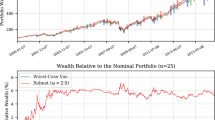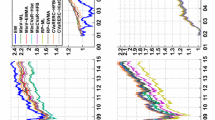Abstract
Risk based portfolio construction and particular risk parity or equally weighted risk contribution became popular among practitioners. These approaches focus only on risk and are agnostic with respect to the expected returns. In this paper, we consider risk budgeting; a generalization of risk parity. We propose an alternative formulation that is more efficient computationally. We introduce the robust risk budgeting, a robust variant of the standard risk budgeting that deals with the uncertainty in the input parameters. We show that the problem remains tractable under different types of uncertainty. We evaluate the proposed framework on real data and we observe a positive premium associated with the robust variant.









Similar content being viewed by others
Notes
\(\varvec{x}^{MV} = argmin \{\varvec{x}^\top Q \varvec{x}:\varvec{x}\ge 0,\varvec{1}^\top \varvec{x}=1\}\)
References
Appell, D. (2009). Bridgewater under the weather. Pensions and Investements.
Artzner, P., Delbaen, F., Eber, J. M. & Heath, D. (1999). Coherent measures of risk. Mathematical Finance, 9(3), 203–228.
Asness, C., Frazzini, A., & Pedersen, L. (2012). Leverage aversion and risk parity. Financial Analysts Journal, 68(1), 47–59.
Bekaert, G., & Wu, G. (2000). Asymmetric volatility and risk in equity markets. The Review of Financial Studies, 13(1), 1–42.
Black, F., & Litterman, R. (1991). Asset allocation: Combining investor views with market equilibrium. Journal of Fixed Income, 1(2), 7–18.
Black, F., & Litterman, R. (1992). Global portfolio optimization. Financial Analysts Journal, 48, 28–43.
Boudt, K., Carl, P., & Peterson, B. G. (2012). Asset allocation with conditional value-at-risk budgets. Journal of Risk, 15(3), 39–68.
Bruder, B., & Roncalli, T. (2012). Managing risk exposures using the risk budgeting approach. Working Paper, Lyxor.
Chaves, D. B., Hsu, J. C., Li, F., & Shakernia, O. (2011). Parity portfolio vs. other asset allocation heuristic portfolios. Journal of Investing, 20(1), 108–118.
Darlington, J., Pantelides, C. C., & Rustem, B. (1999). An algorithm for constrained nonlinear optimization under uncertainty. Automatica, 35(2), 217–228.
DeMiguel, V., Garlappi, L., Nogales, F. J., & Uppal, R. (2009a). A generalized approach to portfolio optimization: Improving performance by constraining portfolio norms. Management Science, 55, 798–812.
DeMiguel, V., Garlappi, L., & Uppal, R. (2009b). Optimal versus naive diversification: How inefficient is the 1/n portfolio strategy? Review of Financial Studies, 22(5), 1915–1953.
Downing, C., Madhavan, A., Singh, A., & Ulitsky, A. (2015). Portfolio construction and tail risk. Working Paper.
Jensen, M. C., Black, F., & Scholes, M. S. (1972). The capital asset pricing model: Some empirical tests. In M. C. Jensen (Ed.), Studies in the theory of capital markets. New York: Praeger. Available at SSRN: https://ssrn.com/abstract=908569.
Kapsos, M., Christofides, N., & Rustem, B. (2014). Worst-case robust omega ratio. European Journal of Operational Research, 234(2), 499–507. (Special Edition: 60 years following Harry Markowitz’s contribution to portfolio theory and operations research).
Kapsos, M., Zymler, S., Christofides, N., & Rustem, B. (2014b). Optimizing omega ratio using linear programming. Journal of Computational Finance, 17(4), 49–57.
Maillard, S., Roncalli, T., & Teïletche, J. (2010). The properties of equally weighted risk contribution portfolios. The Journal of Portfolio Management, 36(4), 60–70.
Markowitz, H. (1952). Portfolio selection. The Journal of Finance, 7(1), 77–91.
Merton, R. (1980). On estimating the expected return on the market: An exploratory investigation. Journal of Financial Economics, 8, 323–361.
Ogryczak, W., & Ruszczyński, A. (2001). On consistency of stochastic dominance and mean-semideviation models. Mathematical Programming, 89(2), 217–232.
Rockafellar, R. T., & Uryasev, S. (2000). Optimization of conditional value-at-risk. Journal of Risk, 2(3), 21–42.
Rockafellar, R. T., Uryasev, S., & Zabarankin, M. (2006). Generalized deviations in risk analysis. Finance and Stochastics, 10(1), 51–74.
Roncalli, T. (2013). Introduction to risk parity and budgeting. Boca Raton: CRC Press.
Sharpe, W. F. (1994). The sharpe ratio. Journal of Portfolio Management, 21, 49–58.
Tütüncü, R. H., & Koenig, M. (2004). Robust asset allocation. Annals of Operations Research, 132, 157–187.
Viceira, L. M. (2007). Life-cycle funds. Harvard Business School, Harvard University, Working Paper.
Zakovic, S., & Rustem, B. (2003). Semi-infinite programming and applications to minimax problems. Annals of Operations Research, 124(1), 81–110.
Zhu, S., & Fukushima, M. (2009). Worst-case conditional value-at-risk with application to robust portfolio management. Operations Research, 57(5), 1155–1168.
Acknowledgements
The authors would like to thank Dr. G. A. Hanasusanto for helpful discussions regarding Appendix A. They also acknowledge partial support of the EPSRC (EP/I014640/1) for the third author and thank the anonymous referees for the comments and suggestions.
Author information
Authors and Affiliations
Corresponding author
A general case: NLP-SDP formulation
A general case: NLP-SDP formulation
Recall, the robust optimization problem under the general case for the uncertainty definition (8–10)
For a fixed \(\varvec{y}\), since \(\varvec{y} ^\top Q \varvec{y} = \Big < Q,\varvec{y} \varvec{y} ^\top \Big>\), the inner problem can be written as
where \(\Big < A,B \Big > = Trace(AB).\) The Lagrangian of the above is
where \(U\ge 0\), \(L\ge 0\) and \(Z\succeq 0\). Therefore, the dual of the above is
Therefore, the optimization problem (18–20) becomes
\(\square \)
Rights and permissions
About this article
Cite this article
Kapsos, M., Christofides, N. & Rustem, B. Robust risk budgeting. Ann Oper Res 266, 199–221 (2018). https://doi.org/10.1007/s10479-017-2469-4
Published:
Issue Date:
DOI: https://doi.org/10.1007/s10479-017-2469-4




